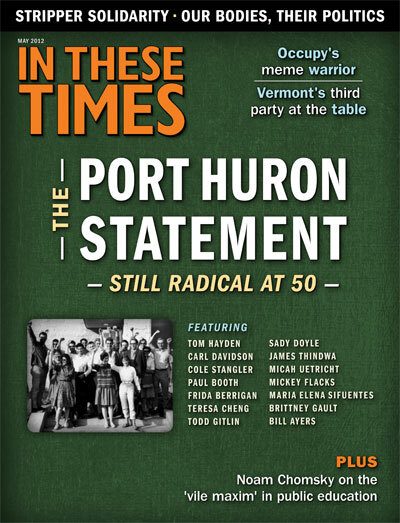Who Needs the White Working Class?
Democratic campaign strategists debate which voters are worth wooing.
David Moberg

In the likely presidential face-off this fall, President Obama will rely on support from a core of young voters, single women, African Americans, Latinos, highly educated voters, liberals and – though often forgotten – union members. Mitt Romney will count on lopsided votes from social and religious conservatives, wealthy business-oriented voters and the anti-Obama crowd – from virulent haters to frustrated voters ready to blame whoever holds power.
Up for grabs is the white working class, which constitutes a key segment of the electorate, especially in the important Midwestern states that are likely to decide what now looks like a close race.
Turning Obama’s current narrow lead in most polls into a victory will depend on voters like those who showed up for the March 20 Illinois primaries at Harnew Elementary School in Oak Lawn, a working-class suburb southwest of Chicago.
Tom Van Loon, a 53-year-old union elevator constructor, wearing a tan Guinness cap as protection against an unseasonably hot sun, has been out of work three years and exhausted his unemployment benefits. He blamed “the banking and mortgage industries” for his plight, not Obama, whom he backs. “My analysis is it’s like sliding down an icy mountain,” he explained. “First, you have to stop the slide, then you work back up. Obama had adverse conditions – not only what he was given to deal with but the opposition to everything he was doing.”
Teacher Maribeth Matuszak said that Obama should tax the rich more to “bring back the middle class.” Political independent Sandi Tickle, a customer service representative, said she was taking a Democratic ballot and backing Obama partly out of anger toward the Republicans: “I don’t like people trying to impose their religious views on my life.” And while bringing her daughter to the polls to cast her first vote, Julianne Touhy approved of Obama’s record but still hoped for greater progress on her two main issues – “money and war: lack of the first, while we should have less of the latter.”
But Obama detractors showed up as well. An angry retired salesman could only sputter, “Get him out,” as his long-suffering Democratic wife quietly explained he had been a Republican all his life. Shirley Gambino, a retired retail clerk, grew up as a Democrat in the neighborhood of former Chicago Mayor Richard J. Daley. But she increasingly voted for Republicans after Reagan, believing they better kept their promises. She and her son – president of a small manufacturing firm, who criticized Democrats for supporting teachers, taxes and trade unions – both voted for Rick Santorum.
“I don’t like everything he says, but I don’t know about Romney,” she said. “There’s something about him I just don’t trust. I think he has all this money. Does he really care about the little people? Santorum seems like a family man.” The Democrats say they’re the party of the little people, I told her. “They’re giving too much to the little people and making the middle men pay for it,” Gambino replied. “I don’t approve of single mothers with four or five children.”
During the primary, Romney has fared worst with Republican voters who do not have a college degree or make less than $50,000 a year – common, if inadequate definitions of “working class.” His weakness with workers – compounded by the anti-union overreaching of Midwest Republican governors and what pollster Stanley Greenberg calls the “collapsing Republican brand” – may open the white working-class door slightly to Obama.
Yet decades of repetition of conservative economic ideology has shaped the thinking of workers whose experience might otherwise provide a contrary view. Greenberg has found that the standard GOP messages (such as Romney’s) on economic freedom and cutting taxes appeal to white voters without a college degree more than Democratic messages about strengthening the middle class and increasing opportunity. At the same time, American workers’ pragmatic progressivism shows through in other polls: three-fourths of white workers want government to reduce inequality, and 55 percent are concerned that not everyone gets an equal chance in life, for example.
Bloc by bloc, vote by vote
Late last year, a debate erupted about whether the Obama campaign should write off the votes of non-college-educated whites. Political analysts Ruy Teixeira and John Halpin argued that Obama could win – despite a landslide loss of the white working class – if he retained his 2008 share of the growing number of white college graduates (or kept the same, lower share of both white college grads and non-graduates that John Kerry won in 2004). The debate over which voting blocs to pursue is also about whether to focus the campaign regionally on new opportunities in the South (such as Florida and North Carolina) and the West (Nevada and Colorado) that rely heavily on communities of color, or on perennial industrial Midwest battlegrounds like Ohio, where white workers make up much of the swing vote.
The white working-class share of the population is shrinking as minority populations grow and more whites graduate from college. Yet in 2008, 56 percent of voters, according to exit polls (compared to 73 percent of all adults, according to the census) had not graduated from college. Moreover, 39 percent of voters were non-college whites – a significant bloc. Nevertheless, sociologist Michael Zweig finds that the working class – people who work for others with limited control over their own work – remains steady: around 62 percent of the labor force, including workers who complete five-year apprenticeships, or even college or higher degrees.
Once a key constituency of the New Deal coalition, since the 1950s the white working class has consistently voted against Democratic presidential candidates – and their own interests. This was especially true in 1972 and in every federal election since 1980, when most white workers have identified with the GOP despite its promotion of anti-labor policies that work against them.
Explanations for the shift vary – backlash against black gains; decline in union membership and influence; diversion from economic interests to conservative social values; a political myopia about which party produces the greatest long-term gains for workers; a rebellion against perceived material costs of Democratic policies regarding taxes, the environment, and eliminating poverty; and Democrats’ neglect of populist, progressive policies to help increasingly stressed moderate-income workers. Yet the relative success that unions had in keeping their members’ support primarily for Democrats, even with sometimes superficial education, also demonstrates the potential for a progressive bloc of white working-class voters.
While he campaigns partly on accomplishments like saving the auto industry, Obama faces his own problems with non-college white voters. He lost the “white working class” to John McCain in 2008 by 18 points, according to CNN, but still won a larger share of non-college white votes than Kerry did in 2004, although Obama was the first Democratic presidential victor to lose that constituency by double digits. In the 2010 congressional shellacking of Democratic candidates, Republicans ran up a 30-point advantage among non-college whites, as key Obama constituencies stayed home while anti-Obama forces voted in droves. Yet voting varied greatly by region: Teixeira and Halpin calculate that in the battleground Midwest and Rust Belt, Republicans had only a two-percent edge among working-class whites, but averaged a 17-percent advantage in competitive Southwest states and a 28-point margin over Democrats in competitive Southern states.
While the Obama campaign has attacked the Republican “war on women,” it has not targeted as explicitly the GOP “war on workers.” “It’s possible to win back white working-class voters, maybe not to get back all the way, but a long way, if the economy improves,” says Hart Research pollster Guy Molyneux. A March NBC poll, for example, showed Romney ahead of Obama among white working-class voters by only five percentage points.
The promise of economic fairness and solidarity that could win over many white workers holds broad voter appeal. It also offers the potential of healing some of the divisions of the working class that are among the main barriers to a more progressive politics in America.
David Moberg, a former senior editor of In These Times, was on staff with the magazine from when it began publishing in 1976 until his passing in July 2022. Before joining In These Times, he completed his work for a Ph.D. in anthropology at the University of Chicago and worked for Newsweek. He received fellowships from the John D. and Catherine T. MacArthur Foundation and the Nation Institute for research on the new global economy.









